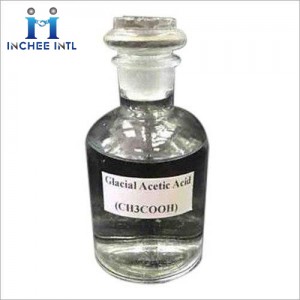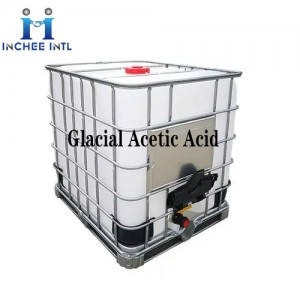
Acetic acid is commonly known as ACOH, named after being the main ingredient of vinegar, and is one of the most important fatty acids. The form of free in nature is generally existed in many plants. Molecular CH3COOH. The brewing and use of vinegar have a history of thousands of years. In ancient China, it was recorded in vinegar. But concentrated acetic acid was a successful Chemicalbook developed by Stahl in 1700. Pure acetic acid is a colorless liquid and has a irritating taste. The melting point is 16.6 ° C, the boiling point is 117.9 ° C, and the relative density is 1.049 (20/4 ° C). Soluble in water, ethanol, glycerin, ether and carbon chloride; insoluble in carbonide. Water -free aquatic crickets are coagulated into ice -shaped, commonly known as ice acetic acid. Corrosive. It is weak and organic acid, acidicity of acid, and can cause esterization reactions with alcohol.
Chemical properties: Acetic acid (AcOH) is a mono-weak carboxylic acid. It has the characteristic properties of carboxylic acids. It reacts with certain metals, metal oxides and hydroxides to form salts. Many acetic acids have important uses. Basic ferric acetate [Fe(C2H3OO)6OH(OOCCH3)2] and [Fe3(C2H3OO)6(OH)2(OOCCH3)] and lead acetate were used as mordant, and ferrous acetate was used for printing. Acetic acid and alcohol were esterified. Esterification can also be carried out with unsaturated hydrocarbon under the action of catalyst. Alpha-hydrogen can be replaced by halogens; And formaldehyde under the action of catalyst, into the Chemicalbook line of alcohol aldehyde condensation; When nitric acid is nitrated in acetic acid, the nitrating rate can be improved. Reacting with benzoyl chloride, acetyl chloride and benzoic acid can be formed. Acetic acid can be used to produce a variety of important derivatives, such as methyl acetate, ethyl ester, propyl ester, butyl ester, etc., is an excellent solvent in the coating and paint industry. Cellulose acetate, produced by the interaction of acetic anhydride and cellulose, can be used to make film, spray paint and various plastics. Carboxymethyl cellulose can be prepared by chloroacetic acid. The vinyl acetate produced by acetic acid and acetylene is an important raw material for the synthesis of drugs, dyes and spices, as well as an important solvent for rubber treatment. Acetic acid plays an important role in industrial production and organic synthesis.
Application field
Industrial use
1. Acetic acid is a large chemical product and is one of the most important organic acids. It is mainly used to produce ethidine, ethyls and ethyl acetate. Polyetate ethyl ester can be made into a film and adhesive, and it is also a raw material for synthetic fiber Velun. Ethyl acetic acid cellulose can make artificial silk and film films.
2. The ethyl acetate formed by low -grade alcohol is an excellent solvent and is widely used in the paint industry. Because most of the organic objects that dissolve the acetic acid, acetic acid is also commonly used organic solvents (for example, for the production of phenyl acidic acid acidic acid acid acid).
3. Acetic acid can be used in some pickled and polished solutions, as a buffer (such as galvanizing and chemical nickel plating) in the weak acid solution, adding additives in a hemuminal bright nickel -plated electrolyte, and passivation of zinc and cadmium The solution can improve the binding force of the passivation film and is often used to regulate the pH of the weak acidic plating.
4. It is used to produce metal salt, such as manganese, sodium, lead, aluminum, zinc, cobalt and other metals, which are widely used as catalysts, fabric dyeing and leather tanning industries. Fouritic acid lead is an organic synthetic reagent (such as tetraitic acid lead can be used as a strong oxidant, a source of acetyl oxygen, and preparing organic lead compounds, etc.).
5. Acetic acid can also be used as analytical reagents, organic synthesis, pigment and medicine synthesis.
Food use
In the food industry, acetic acid is used as a acidified agent. When the fragrance agent and spice are used to make synthetic vinegar, the acetic acid is diluted to 4-5%, and a variety of flavors are added. Cheap. As a acid -flavored agent, it can be used for composite seasonings. It is prepared to use vinegar, cans, jelly and cheese. You can also compose fragrance agents with 0.1 ~ 0.3 g/kg.
Storage and transportation
Storage precautions: Store in a cool, ventilated warehouse. Keep away from fire and heat. In winter, the storage temperature should be kept above 16℃ to prevent solidification. Keep the container sealed. It should be stored separately from oxidant and alkali, and should not be mixed. Explosion-proof lighting and ventilation facilities are adopted. Do not use mechanical equipment and tools that are prone to spark. The storage area should be equipped with leak emergency treatment equipment and suitable holding materials.
Transport precautions:This product will be shipped by aluminum tank cars provided by aluminum enterprises during railway transportation, and approval of relevant departments shall be reported before shipment. The non-canned railway transportation shall be carried out in strict accordance with the dangerous goods packing list in the "Dangerous Goods Transportation Rules" of the Ministry of Railways. The packing should be complete and the loading should be safe. During transportation, ensure that the container does not leak, collapse, fall or damage. The trough (tank) car used in transportation should have a grounding chain, and a hole partition can be arranged in the trough to reduce static electricity generated by shock. It is strictly prohibited to mix with oxidant, alkali and edible chemicals. Road transport should follow the prescribed route, do not stay in residential and densely populated areas.

Post time: Mar-23-2023






